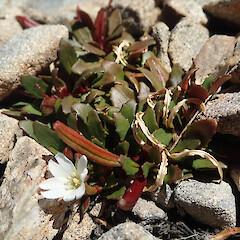Epilobium margaretiae
Common name
willowherb
Synonyms
None
Family
Onagraceae
Flora category
Vascular – Native
Endemic taxon
Yes
Endemic genus
No
Endemic family
No
Structural class
Herbs - Dicotyledons other than Composites
Chromosome number
2n = 36
Current conservation status
The conservation status of all known New Zealand vascular plant taxa at the rank of species and below were reassessed in 2017 using the New Zealand Threat Classification System (NZTCS) – more information about this can be found on the NZTCS website. This report includes a statistical summary and brief notes on changes since 2012 and replaces all previous NZTCS lists for vascular plants.
Please note, threat classifications are often suggested by authors when publications fall between NZTCS assessment periods – an interim threat classification status has not been assessed by the NZTCS panel.
- Conservation status of New Zealand indigenous vascular plants, 2017 . 2018. Peter J. de Lange, Jeremy R. Rolfe, John W. Barkla, Shannel P. Courtney, Paul D. Champion, Leon R. Perrie, Sarah M. Beadel, Kerry A. Ford, Ilse Breitwieser, Ines Schönberger, Rowan Hindmarsh-Walls, Peter B. Heenan and Kate Ladley. Department of Conservation. Source: NZTCS and licensed by DOC for reuse under the Creative Commons Attribution 4.0 International licence.
2017 | At Risk – Naturally Uncommon | Qualifiers: RR, Sp
Previous conservation statuses
2012 | At Risk – Naturally Uncommon | Qualifiers: RR, Sp
2009 | At Risk – Naturally Uncommon
2004 | Range Restricted
Distribution
Endemic. South Island, Nelson where it known from Kahurangi National Park (mt Arthur, Mt Peel, The Iron Hills) and in the east from the Travers and Byrant Ranges and the Mole Tops
Habitat
High alpine (1300-1700 m a.s.l.) confined to steep ridge lines and crests where it grows in open, metamorphic rock rubble and fell field.
Detailed description
Creeping, glabrous perennial herb. Stems reddish 20-150 mm long, branching and rooting at nodes; dry leaves long persistent. Leaves crowded on stems, opposite, succulent, secund, glossy; lateral veins 1-3 each side of midrib, not evident when fresh; petiole 0-2(-10) mm long; lamina 3-16 x 2-5 mm, dark green to red-green, oblanceolate, apex acute or obtuse, base attenuate, margins distantly serrulate, bearing 4-10 teeth. Flowers borne in leaf axils, 2-4 per season, erect. Ovary 5-8 mm long, fleshy, reddish, glossy; pedicels 10 mm long at flowering often elongating slightly in fruit. Floral tube 3.0-5.0 x 1.3-3.0 mm, glabrous, holding much nectar. Sepals 3.5-6.2 x 1.4-1.5 mm, glabrous, weakly keeled. Petals white, 7.0-9.0 x 3.5-4.6 mm, apices notched, notch 1.4-2.7 mm deep. Anthers 1.0-1.2, yellow; filaments of longer stamens 2.7-7.4 mm long, those of shorter 1.3-4.0 mm long. Style 5.5-8.0 mm, white; stigma 0.6-1.5 x 0.3-0.9 mm, white, narrowly clavate. Capsules weakly falcate, 10-20 mm long, rather stout and glabrous. Seeds 1.5 x 0.6 mm, brown, smooth, coma 4-6 mm long, white, detaching readily.
Similar taxa
A distinctive species easily separated from other New Zealand epilobia by consistently opposite leaves and the very long floral tube (3-5 mm deep).
Flowering
December - January
Flower colours
White, Yellow
Fruiting
January - March
Life cycle
Minute pappate seeds are wind dispersed (Thorsen et al., 2009).
Propagation technique
Difficult - should not be removed from the wild
Threats
Not threatened. Listed because it is a narrow range endemic of limited geographic extent. It is regarded as common in the few places from which it has been recorded.
Etymology
epilobium: From the Greek epi- ‘upon’ and lobos ‘a pod’, the flowers appearing to be growing on the seed pod.
Where To Buy
Not commercially available.
Attribution
Fact sheet prepared for NZPCN by P.J. de Lange 6 January 2008. Description adapted from Raven & Raven (1976) and Webb & Simpson (2001).
References and further reading
Raven, P.H.; Raven, T.E. 1976: The genus Epilobium in Australasia. New Zealand DSIR Bulletin 216. Wellington, Government Printer.
Thorsen, M. J.; Dickinson, K. J. M.; Seddon, P. J. 2009. Seed dispersal systems in the New Zealand flora. Perspectives in Plant Ecology, Evolution and Systematics 11: 285-309
Webb, C.J.; Simpson, M.J.A. 2011: Seeds of New Zealand Gymnosperms and Dicotyledons. Christchurch, Manuka Press.
NZPCN Fact Sheet citation
Please cite as: de Lange, P.J. (Year at time of access): Epilobium margaretiae Fact Sheet (content continuously updated). New Zealand Plant Conservation Network. https://www.nzpcn.org.nz/flora/species/epilobium-margaretiae/ (Date website was queried)








